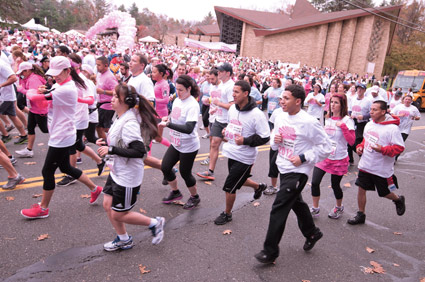
By Debbie Gardner
debbieg@thereminder.com
The 22nd Rays of Hope Walk and Run Toward the Cure for Breast Cancer takes place on Oct. 30 this year. PRIME thanks Dr. Grace Makari-Judson, co-director, The Rays of Hope Center for Breast Cancer Research and chair, Baystate Health Breast Network for a research update, and Kathy Tobin, director, Annual Giving & Events, Baystate Health Foundation, for a look at how the walk changes lives.
Q: Every year brings new medical discoveries. What are the latest findings in the field of breast cancer?
“One recurring theme is that of minimally invasive surgery. When a woman has surgery for invasive breast cancer, the surgery has included evaluation of the lymph nodes under the arm (axilla) in a procedure called sentinel lymph node biopsy, which in many cases has replaced complete dissection of the axilla. Recently, for select older patients with favorable types of breast cancer, it may be possible to eliminate sentinel node surgery altogether.
“In women that have cancer involving the lymph nodes that are undergoing upfront chemotherapy, we have two clinical trials at Baystate Medical Center to address the question of whether or not radiation can take the place of the more extensive complete axillary surgery. The goals are to avoid the side effects associated with that surgery while still minimizing recurrence.
“Some women over 50 may be candidates to receive a shorter course of radiation, completed in three rather than five-to-six weeks. Experts endorse this “hypofractionated” radiation for women who meet select criteria. At Baystate, we have developed practice guidelines to assure that women are being considered for this option.
“These strategies emphasize the need for cancer specialists to address when to recommend more extensive treatment, and when can we minimize treatment– and the side effects – but not compromise cure.”
8 K Run steps off at 8:30 a.m. • Walk steps off at 10:30 a.m.
Info: http://bayhf.convio.net
Q: In what ways has new research influenced treatment options?
“Because estrogen receptor positive breast cancer can recur many years later, an important research question has been “how long should women stay on treatment?” This June, we obtained results from a large study that shows 10 years of the AI, letrozole further lowered risk breast cancer recurrence when compared to five years.
“How do we use this information in practice? Longer duration of medication can mean more time to develop side effects like osteoporosis or fractures. In our day-to-day practice, medical oncologists need to have detailed discussions on advantages and disadvantages of longer vs. shorter duration treatment with each individual patient. For many women who are at high risk of recurrence and are currently tolerating an AI, having the option to stay on longer is great news.
“New drugs have been important in the treatment of women with metastatic breast cancer. We have several clinical trials at Baystate investigating some of these promising agents.
“Whether we are talking about surgical options, radiation treatments or new drugs to treat breast cancer, patients should always inquire about clinical trials. It is through the courage and resilience of the women before them that we have results of clinical trials to guide us in decisions we make today.”
Q: The Rays of Hope Walk has supported breast cancer patients and research since 1994. Are there plans in place for this year’s walk proceeds?
“Importantly, all money – $13 million to date – raised by Rays of Hope stays local. The primary focus of the Walk & Run for a Cure is to fund local research at the Rays of Hope Center for Breast Cancer Research. Currently, researchers at Baystate Health and UMass-Amherst are studying environmental factor exposures to breast cancer risk, a project started with Rays of Hope seed money that later secured a very competitive $3.5 million grant from the National Institute of Environmental Health Sciences and the National Cancer Institute. The study uses breast tissue from local women in the Rays of Hope Breast Research Registry.
“Additionally, Rays of Hope provides annual community grants for outreach, education and services like support groups and programs throughout western Massachusetts.